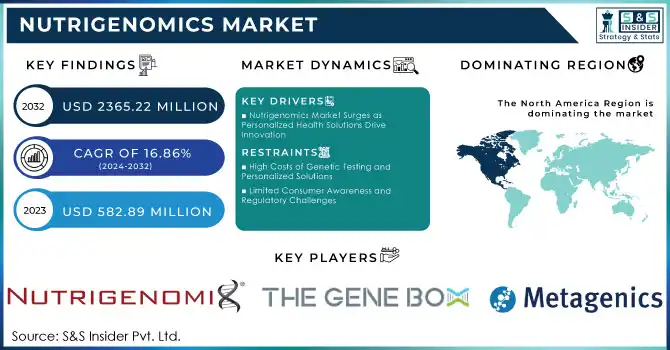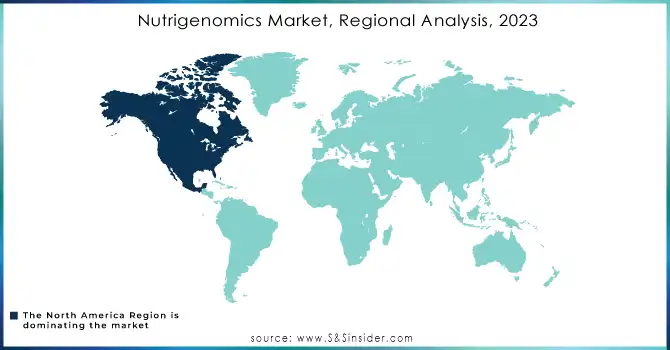Nutrigenomics Market Size & Growth Overview:

To Get More Information on Nutrigenomics Market - Request Sample Report
The Nutrigenomics Market Size valued at USD 582.89 million in 2023 and is projected to reach USD 2365.22 million by 2032, with a growing CAGR of 16.86% during the forecast period of 2024-2032.
The nutrigenomics market is witnessing significant growth as it revolutionizes the intersection of nutrition and genetics. This innovative field tailors dietary recommendations based on individual genetic profiles, offering personalized strategies to prevent and manage chronic conditions like obesity, diabetes, and cardiovascular diseases. Studies have revealed how genetic variations, such as those in the FTO and APOA2 genes, impact metabolism and dietary responses, highlighting the potential of nutrigenomics in addressing unique nutritional needs.
The surge in chronic diseases has increased demand for preventive healthcare solutions, making nutrigenomics pivotal in reshaping health management. Functional foods and supplements form a significant part of this market, enabling consumers to target specific health goals. For instance, omega-3 supplements are recommended for individuals with certain inflammation-related genetic markers. The integration of artificial intelligence and big data analytics has further propelled the market, offering precise insights into gene-diet interactions and enabling the development of effective nutritional strategies.
Collaborations between healthcare providers, research institutions, and nutrigenomics companies are accelerating advancements in the field. Research emphasizes that nutrigenomics enhances individual health outcomes and has implications for public health policies, especially in mitigating risks associated with non-communicable diseases.
As consumer awareness about personalized wellness grows and technological innovations continue to drive deeper genetic insights, nutrigenomics is emerging as a cornerstone of preventative and precision healthcare. This dynamic market is poised to transform the global health landscape by enabling individuals to make informed dietary choices tailored to their genetic makeup.
Market Dynamics
Drivers
-
Nutrigenomics Market Surges as Personalized Health Solutions Drive Innovation
The nutrigenomics market is propelled by rising consumer awareness of personalized health solutions and the growing prevalence of chronic diseases such as obesity, diabetes, and cardiovascular disorders. Advances in genomic research and technologies like AI and machine learning have made genetic testing more accessible and precise, enabling tailored dietary recommendations. Functional foods and supplements aligned with genetic insights have gained traction, driven by the increasing demand for preventive healthcare solutions.
The global shift toward precision medicine and wellness also drives the market. Nutrigenomics offers unique opportunities to address lifestyle-related disorders by identifying genetic markers that influence nutrient absorption and metabolism. For example, individuals with variations in the MTHFR gene benefit from folate-rich diets, showcasing the potential for targeted interventions.
Collaborations between nutrigenomics companies, healthcare providers, and research institutions are expanding the adoption of these technologies while growing investments in research and development accelerate innovation. Consumer preferences for evidence-based dietary solutions and the integration of big data analytics further enhance the market's growth prospects.
In addition, government and institutional initiatives, such as strategic plans from organizations like the NIH, support advancements in nutritional genomics to tackle public health challenges. These factors collectively drive the expansion of the nutrigenomics market, positioning it as a transformative force in healthcare.
Restraints
-
High Costs of Genetic Testing and Personalized Solutions
The expense associated with genetic testing and customized dietary recommendations limits accessibility, particularly in developing regions with lower disposable incomes.
-
Limited Consumer Awareness and Regulatory Challenges
A lack of widespread understanding of nutrigenomics and varying global regulatory standards for genetic testing and functional foods hinder market growth.
Segmentation Insights
By Product
The Reagents & Kits segment dominated the nutrigenomics market in 2023, holding a significant market share of approximately 60.0%. Reagents and kits are essential components in the genetic testing process, providing the tools needed to extract, analyze, and interpret genetic material from biological samples. These products are crucial for both clinical and research applications, enabling the identification of genetic variations that influence an individual’s nutritional needs. The widespread use of these reagents and kits in hospitals, clinics, and research institutions for genetic testing contributes to their dominant position in the market. As the demand for personalized nutrition and precision health solutions increases, the role of reagents and kits remains fundamental to the nutrigenomics industry.
The Services segment, including genetic counseling and personalized nutrition services, is experiencing rapid growth. This growth is driven by an increasing consumer demand for tailored health solutions, as more individuals seek personalized nutrition based on genetic testing results. As advancements in genomics and genetic testing make these services more accessible, healthcare providers and research institutions are expanding their offerings in this area. Services such as genetic testing consultations, customized diet planning, and continuous monitoring are expected to witness significant growth, making this segment the fastest growing in the nutrigenomics market. Projected to grow at a CAGR of 11%, this segment's expansion is a response to the global shift toward precision health and wellness.
By Application
The Obesity application dominated the nutrigenomics market in 2023, accounting for approximately 35.0% of the market share. Obesity is a growing global concern, with increasing prevalence linked to lifestyle choices, genetic predispositions, and environmental factors. Nutrigenomics plays a vital role in addressing this issue by offering personalized dietary recommendations based on genetic analysis. By identifying genes involved in metabolism, appetite regulation, and fat storage, nutrigenomics allows for more effective and individualized interventions. As consumers and healthcare providers focus more on personalized health and preventive measures, the obesity segment continues to lead the market.
The Cardiovascular Diseases application is the fastest growing in the nutrigenomics market. With the rising global incidence of cardiovascular diseases, there is a heightened focus on early diagnosis and personalized prevention strategies. Nutrigenomics provides valuable insights into genetic variations that influence heart health, such as those affecting cholesterol levels, blood pressure, and inflammation. By offering tailored dietary recommendations and lifestyle changes based on genetic profiles, nutrigenomics is increasingly used to manage and prevent cardiovascular risk factors. This segment is expected to grow at a CAGR of 12%, driven by the growing demand for precision medicine in the prevention and management of heart disease.
Regional Analysis
The North American region was the leading market for nutrigenomics, holding a substantial share of the global market in 2023. This dominance is fueled by the widespread adoption of personalized health solutions, significant advancements in genomic research, and a robust healthcare infrastructure. The United States plays a key role in this growth, driven by a rising consumer demand for preventive healthcare and genetic testing services. Factors such as high disposable incomes, increasing awareness of health issues like obesity and cardiovascular diseases, and the presence of prominent nutrigenomics companies contribute to the region's growth. North America is expected to continue its leadership in the coming years, supported by ongoing innovation, strategic partnerships, and substantial investments in research and development.
Europe followed closely behind, with countries like Germany, the UK, and France at the forefront of the market. The region's nutrigenomics market is driven by growing consumer interest in personalized nutrition and the support of government initiatives that promote the integration of genomics into healthcare. Additionally, the increasing demand for functional foods and supplements, that offer preventive health benefits, is helping to expand the market. As European consumers increasingly prioritize health and wellness, the market is projected to experience steady growth.
The Asia-Pacific region is emerging as the fastest-growing market for nutrigenomics, driven by heightened healthcare awareness, the rising prevalence of lifestyle-related diseases, and broader access to genetic testing. Countries such as China, India, and Japan are seeing a surge in demand for nutrigenomics services, spurred by an expanding, health-conscious population. The rapid urbanization and growing middle class in this region are expected to fuel the sector's growth in the years ahead.

Key Nutrigenomics Companies
-
Nutrigenomix - DNAfit Nutrigenomics Testing, Genetic Testing for Personalized Nutrition
-
The Gene Box - Gene Box Health Report, Nutrigenomics Test
-
Metagenics - DNA Methylation Support, Nutrigenomic Testing Panels
-
Xcode Life - Genetic Nutrition Reports, DNA-based Weight Loss & Diet Plan
-
GX Sciences, LLC (Fagron) - Nutrigenomic Testing Kit, DNA-based Personalized Health & Wellness Reports
-
Cura Integrative Medicine - Nutrigenomic Test for Personalized Wellness
-
dnalife - DNA Test for Personalized Health, Nutrigenomics Reports
-
Genova Diagnostics (GDX) - Nutrigenomic Health Panel, Genetic Health Profile
-
HOLISTIC HEALTH INTERNATIONAL, LLC - Genetic Health Reports, Personalized Nutrigenomics Testing
-
Vitagene - DNA Test for Personalized Nutrition, Custom Supplement Plan
-
Mapmygenome - Genomepatri (Genomic Health Report), MyGenome Report
-
Gini Health - Personalized Health Reports, Nutritional DNA Reports
-
geneOmbio - Genetic Health Testing, DNA Reports for Personalized Nutrition
-
23andMe Inc. - Health + Ancestry DNA Test, Personalized Health Reports
-
DNAfit - DNAfit Nutritional Testing, Fitness & Diet Reports
-
GX Sciences Inc. - Nutrigenomic Health Tests, Customized Nutrition Recommendations
Recent Developments
In June 2023, Xcode Life launched the Gene Nutrition Test, which covers nearly 50 aspects of nutrition. This test helps individuals understand how their genes affect metabolism, nutrient absorption, and food sensitivities, providing personalized and credible nutrition recommendations tailored to their unique genetic profile.
In June 2023, GX Sciences partnered with GetHairMD to offer personalized hair loss solutions, leveraging genetic insights for targeted treatments. This collaboration aims to provide customized solutions based on individual genetic profiles, enhancing the effectiveness of hair loss management strategies.
| Report Attributes | Details |
|---|---|
| Market Size in 2023 | US$ 582.89 Million |
| Market Size by 2032 | US$ 2365.22 Million |
| CAGR | CAGR of 16.86% From 2024 to 2032 |
| Base Year | 2023 |
| Forecast Period | 2024-2032 |
| Historical Data | 2020-2022 |
| Report Scope & Coverage | Market Size, Segments Analysis, Competitive Landscape, Regional Analysis, DROC & SWOT Analysis, Forecast Outlook |
| Key Segments | • By Product (Reagents & Kits, Services) • By Application (Obesity, Cardiovascular Diseases, Cancer Research, Others) • By Technique (Saliva, Buccal Swab, Blood) • By End Use (Hospitals & Clinics, Others) |
| Regional Analysis/Coverage | North America (US, Canada, Mexico), Europe (Eastern Europe [Poland, Romania, Hungary, Turkey, Rest of Eastern Europe] Western Europe] Germany, France, UK, Italy, Spain, Netherlands, Switzerland, Austria, Rest of Western Europe]), Asia Pacific (China, India, Japan, South Korea, Vietnam, Singapore, Australia, Rest of Asia Pacific), Middle East & Africa (Middle East [UAE, Egypt, Saudi Arabia, Qatar, Rest of Middle East], Africa [Nigeria, South Africa, Rest of Africa], Latin America (Brazil, Argentina, Colombia, Rest of Latin America) |
| Company Profiles | Nutrigenomix, The Gene Box, Metagenics, Xcode Life, GX Sciences, LLC (Fagron), Cura Integrative Medicine, dnalife, Genova Diagnostics (GDX), HOLISTIC HEALTH INTERNATIONAL, LLC, Vitagene, Mapmygenome, Gini Health, geneOmbio, 23andMe Inc., DNAfit, GX Sciences Inc. |
| Key Drivers | • Nutrigenomics Market Surges as Personalized Health Solutions Drive Innovation |
| Restraints | • High Costs of Genetic Testing and Personalized Solutions • Limited Consumer Awareness and Regulatory Challenges |

